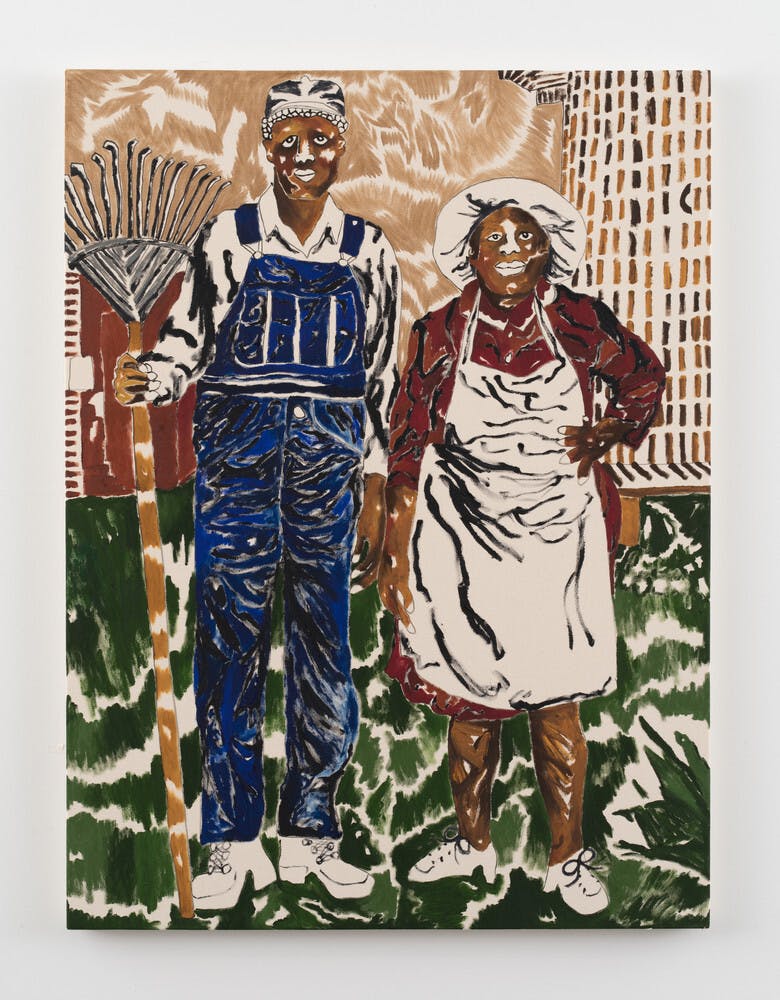Chase Hall
(b. 1993)Chase Hall investigates the weighted histories of objects and the dissemination of notions of blackness.
Biography
Across painting and sculpture, Chase Hall uses materials such as cotton, coffee, bricks, and barricades to make sociopolitical commentary on the legacies of enslavement and colonialism.
He was born in St. Paul, Minnesota to a Black father and white mother. Raised primarily by his mother, he moved around with her as she took odd jobs in Chicago, Las Vegas, Dubai, back to Vegas, and then to Los Angeles. In his high school, he was one of the only Black students. Despite taking classes in photography and ceramics, he found histories and debate to be more exciting. At age fourteen, he began working at Starbucks. Over the next three years, he made small sketches using brewed coffee—a material that would go on to form a critical element of his practice. After graduating high school, he worked as an administrative assistant in real estate, where he witnessed his boss buy work by artists such as Pablo Picasso and Andy Warhol. He was struck by the realization that he wanted to work creatively and, in 2013, he moved to New York to become a photographer.
Hall worked as a line cook and photographed people on the street. He visited museums and galleries, and had a formative visit to the Museum of Modern Art, where he encountered a work by Henry Taylor, whose works he saw as accessible and against traditional ideals of perfection. As he sought to build his knowledge of art and painting practice, he used syllabi from college courses, buying the books and going to see exhibitions of those artists. He was a residence at the Skowhegan School for Painting and Sculpture in 2019. Since then, his practice has reflected the intricacies of his biracial heritage. In his gestural portraits, the white of his compositions is not white paint but rather the unmarked, unprimed cotton canvas, while the black and brown hues are stains from African coffee beans. Through these materials, Hall alludes to and investigates histories of landscape and labor as indexed by race.
Hall has completed residencies at the Skowhegan (2019); Massachusetts Museum of Contemporary Art (2020); and Silver Arts Project (2021). His work first entered the Studio Museum permanent collection in 2020.
Chase Hall
(b. 1993)Chase Hall investigates the weighted histories of objects and the dissemination of notions of blackness.
African-American Gothic, 2020
Biography
Across painting and sculpture, Chase Hall uses materials such as cotton, coffee, bricks, and barricades to make sociopolitical commentary on the legacies of enslavement and colonialism.
He was born in St. Paul, Minnesota to a Black father and white mother. Raised primarily by his mother, he moved around with her as she took odd jobs in Chicago, Las Vegas, Dubai, back to Vegas, and then to Los Angeles. In his high school, he was one of the only Black students. Despite taking classes in photography and ceramics, he found histories and debate to be more exciting. At age fourteen, he began working at Starbucks. Over the next three years, he made small sketches using brewed coffee—a material that would go on to form a critical element of his practice. After graduating high school, he worked as an administrative assistant in real estate, where he witnessed his boss buy work by artists such as Pablo Picasso and Andy Warhol. He was struck by the realization that he wanted to work creatively and, in 2013, he moved to New York to become a photographer.
Hall worked as a line cook and photographed people on the street. He visited museums and galleries, and had a formative visit to the Museum of Modern Art, where he encountered a work by Henry Taylor, whose works he saw as accessible and against traditional ideals of perfection. As he sought to build his knowledge of art and painting practice, he used syllabi from college courses, buying the books and going to see exhibitions of those artists. He was a residence at the Skowhegan School for Painting and Sculpture in 2019. Since then, his practice has reflected the intricacies of his biracial heritage. In his gestural portraits, the white of his compositions is not white paint but rather the unmarked, unprimed cotton canvas, while the black and brown hues are stains from African coffee beans. Through these materials, Hall alludes to and investigates histories of landscape and labor as indexed by race.
Hall has completed residencies at the Skowhegan (2019); Massachusetts Museum of Contemporary Art (2020); and Silver Arts Project (2021). His work first entered the Studio Museum permanent collection in 2020.
